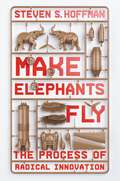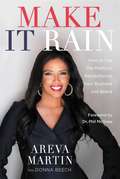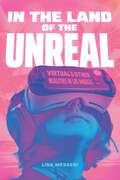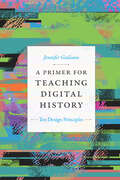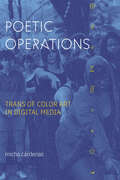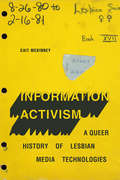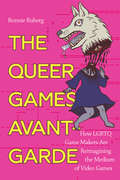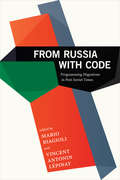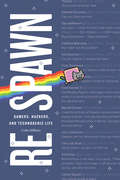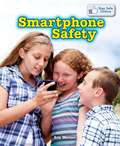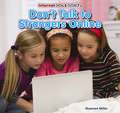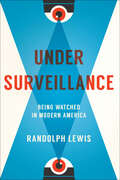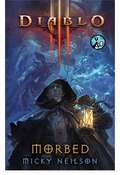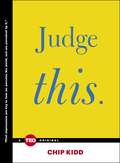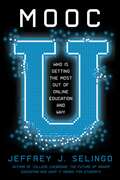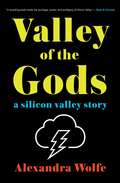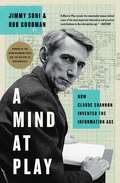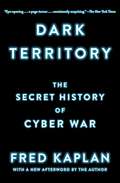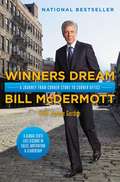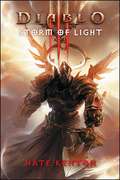- Table View
- List View
Make Elephants Fly: The Process of Radical Innovation
by Steven S. HoffmanDrawing on examples of the hottest innovators in Silicon Valley, this step-by-step guide will show you how to develop, test and launch your impossibly big idea to success. Almost every major company today has made innovation its number one priority. Yet fewer than one in four executives believe their organizations are effective innovators. The pressure to innovate and the price paid for failure keeps rising, while most companies haven't progressed at all. They are still using the same antiquated techniques pioneered decades ago. This is why some of the biggest corporations in the world manage to lose entire markets to startups they've never heard of.In today's world, everyone will need to innovate to stay competitive. It doesn't matter if you're a startup founder, corporate executive, small business owner, freelancer or professional, there's a technology out there that's going to upend your industry. And if you aren't able to harness it to your advantage, someone else will. Innovation is no longer an option--it's the price of admission into the business world.Make Elephants Fly is designed to help you implement the same innovation methodologies and processes as Silicon Valley startups. It will teach you: How startups come up with breakthrough products and services. How to structure innovation teams. The best ways to identify and vet new ideas. What it takes to foster a culture of innovation. How to establish a process of innovation throughout your organization.By the time you've digested this book, you will have the tools needed to take your impossibly big idea and make it fly!
Make It Rain!: How To Use The Media To Revolutionize Your Business & Brand
by Areva Martin Donna Beech Phil McGrawWhat if you could get in front of millions of prospects with the avid endorsement of famous influencers--without spending a dime?It's happening right in front of you every day. Guest experts on TV, radio, podcasts, blogs, and live streaming are getting local and national exposure for their business and brand that they could never have afforded to reach with ads.For a decade, Areva Martin has used the media to build a huge platform that expanded the influence and power of her brand exponentially. Media appearances on Dr. Phil, Anderson Cooper 360, The Doctors, CNN, MSNBC, FOX, and more have virtually eliminated the need of a marketing budget for her thriving law firm and non-profit organization, while securing her place as one of America's most sought after thought leaders.In Make It Rain! Areva breaks the silence to reveal what insiders know about the power of media appearances to revolutionize a business and brand and get your core message out to the people who need it most. You'll learn how to: Match your brand to the right audience and media venues Craft pitches producers can't resist Jump on breaking news shows Pivot and speak in soundbites like the pros Amplify every interview with social media Turn appearances into platform and become a rainmakerNever before have there been more ways to build a presence that matters. Whether you are the executive of a corporation, the author of an upcoming book, the owner of a rapidly growing small business, or the public face of a local nonprofit or association, if you have a business to build or people you want to help, nothing beats using the media to create the visibility, influence, and power you need. Are you ready to Make It Rain!?
In the Land of the Unreal: Virtual and Other Realities in Los Angeles
by Lisa MesseriIn the mid-2010s, a passionate community of Los Angeles-based storytellers, media artists, and tech innovators formed around virtual reality (VR), believing that it could remedy society’s ills. Lisa Messeri offers an ethnographic exploration of this community, which conceptualized VR as an “empathy machine” that could provide glimpses into diverse social realities. She outlines how, in the aftermath of #MeToo, the backlash against Silicon Valley, and the turmoil of the Trump administration, it was imagined that VR—if led by women and other marginalized voices—could bring about a better world. Messeri delves into the fantasies that allowed this vision to flourish, exposing the paradox of attempting to use a singular VR experience to mend a fractured reality full of multiple, conflicting social truths. She theorizes this dynamic as unreal, noting how dreams of empathy collide with reality’s irreducibility to a “common” good. With In the Land of the Unreal, Messeri navigates the intersection of place, technology, and social change to show that technology alone cannot upend systemic forces attached to gender and race.
A Primer for Teaching Digital History: Ten Design Principles (Design Principles for Teaching History)
by Jennifer GuilianoA Primer for Teaching Digital History is a guide for college and high school teachers who are teaching digital history for the first time or for experienced teachers who want to reinvigorate their pedagogy. It can also serve those who are training future teachers to prepare their own syllabi, as well as teachers who want to incorporate digital history into their history courses. Offering design principles for approaching digital history that represent the possibilities that digital research and scholarship can take, Jennifer Guiliano outlines potential strategies and methods for building syllabi and curricula. Taking readers through the process of selecting data, identifying learning outcomes, and determining which tools students will use in the classroom, Guiliano outlines popular research methods including digital source criticism, text analysis, and visualization. She also discusses digital archives, exhibits, and collections as well as audiovisual and mixed-media narratives such as short documentaries, podcasts, and multimodal storytelling. Throughout, Guiliano illuminates how digital history can enhance understandings of not just what histories are told but how they are told and who has access to them.
Poetic Operations: Trans of Color Art in Digital Media (ASTERISK)
by micha cárdenasIn Poetic Operations artist and theorist micha cárdenas considers contemporary digital media, artwork, and poetry in order to articulate trans of color strategies for safety and survival. Drawing on decolonial theory, women of color feminism, media theory, and queer of color critique, cárdenas develops a method she calls algorithmic analysis. Understanding algorithms as sets of instructions designed to perform specific tasks (like a recipe), she breaks them into their component parts, called operations. By focusing on these operations, cárdenas identifies how trans and gender-non-conforming artists, especially artists of color, rewrite algorithms to counter violence and develop strategies for liberation. In her analyses of Giuseppe Campuzano's holographic art, Esdras Parra's and Kai Cheng Thom's poetry, Mattie Brice's digital games, Janelle Monáe's music videos, and her own artistic practice, cárdenas shows how algorithmic analysis provides new modes of understanding the complex processes of identity and oppression and the intersection of gender, sexuality, and race.
Information Activism: A Queer History of Lesbian Media Technologies (Sign, Storage, Transmission)
by Cait McKinneyFor decades, lesbian feminists across the United States and Canada have created information to build movements and survive in a world that doesn't want them. In Information Activism Cait McKinney traces how these women developed communication networks, databases, and digital archives that formed the foundation for their work. Often learning on the fly and using everything from index cards to computers, these activists brought people and their visions of justice together to organize, store, and provide access to information. Focusing on the transition from paper to digital-based archival techniques from the 1970s to the present, McKinney shows how media technologies animate the collective and unspectacular labor that sustains social movements, including their antiracist and trans-inclusive endeavors. By bringing sexuality studies to bear on media history, McKinney demonstrates how groups with precarious access to control over information create their own innovative and resourceful techniques for generating and sharing knowledge.
The Queer Games Avant-Garde: How LGBTQ Game Makers Are Reimagining the Medium of Video Games
by Bonnie RubergIn The Queer Games Avant-Garde, Bonnie Ruberg presents twenty interviews with twenty-two queer video game developers whose radical, experimental, vibrant, and deeply queer work is driving a momentous shift in the medium of video games. Speaking with insight and candor about their creative practices as well as their politics and passions, these influential and innovative game makers tell stories about their lives and inspirations, the challenges they face, and the ways they understand their places within the wider terrain of video game culture. Their insights go beyond typical conversations about LGBTQ representation in video games or how to improve “diversity” in digital media. Instead, they explore queer game-making practices, the politics of queer independent video games, how queerness can be expressed as an aesthetic practice, the influence of feminist art on their work, and the future of queer video games and technology. These engaging conversations offer a portrait of an influential community that is subverting and redefining the medium of video games by placing queerness front and center.Interviewees:Ryan Rose Aceae, Avery Alder, Jimmy Andrews, Santo Aveiro-Ojeda, Aevee Bee, Tonia B******, Mattie Brice, Nicky Case, Naomi Clark, Mo Cohen, Heather Flowers, Nina Freeman, Jerome Hagen, Kat Jones, Jess Marcotte, Andi McClure, Llaura McGee, Seanna Musgrave, Liz Ryerson, Elizabeth Sampat, Loren Schmidt, Sarah Schoemann, Dietrich Squinkifer, Kara Stone, Emilia Yang, Robert Yang
From Russia with Code: Programming Migrations in Post-Soviet Times
by Mario Biagioli Vincent Antonin LépinayWhile Russian computer scientists are notorious for their interference in the 2016 US presidential election, they are ubiquitous on Wall Street and coveted by international IT firms and often perceive themselves as the present manifestation of the past glory of Soviet scientific prowess. Drawing on over three hundred in-depth interviews, the contributors to From Russia with Code trace the practices, education, careers, networks, migrations, and lives of Russian IT professionals at home and abroad, showing how they function as key figures in the tense political and ideological environment of technological innovation in post-Soviet Russia. Among other topics, they analyze coders' creation of both transnational communities and local networks of political activists; Moscow's use of IT funding to control peripheral regions; brain drain and the experiences of coders living abroad in the United Kingdom, United States, Israel, and Finland; and the possible meanings of Russian computing systems in a heterogeneous nation and industry. Highlighting the centrality of computer scientists to post-Soviet economic mobilization in Russia, the contributors offer new insights into the difficulties through which a new entrepreneurial culture emerges in a rapidly changing world. Contributors. Irina Antoschyuk, Mario Biagioli, Ksenia Ermoshina, Marina Fedorova, Andrey Indukaev, Alina Kontareva, Diana Kurkovsky, Vincent Lépinay, Alexandra Masalskaya, Daria Savchenko, Liubava Shatokhina, Alexandra Simonova, Ksenia Tatarchenko, Zinaida Vasilyeva, Dimitrii Zhikharevich
Respawn: Gamers, Hackers, and Technogenic Life (Experimental Futures)
by Colin MilburnIn Respawn Colin Milburn examines the connections between video games, hacking, and science fiction that galvanize technological activism and technological communities. Discussing a wide range of games, from Portal and Final Fantasy VII to Super Mario Sunshine and Shadow of the Colossus, Milburn illustrates how they impact the lives of gamers and non-gamers alike. They also serve as resources for critique, resistance, and insurgency, offering a space for players and hacktivist groups such as Anonymous to challenge obstinate systems and experiment with alternative futures. Providing an essential walkthrough guide to our digital culture and its high-tech controversies, Milburn shows how games and playable media spawn new modes of engagement in a computerized world.
Smartphone Safety
by Eric MintonSmartphones offer convenience and fun, but it is important to use them safely. This title points out phone features that owners can use to make their smartphones more secure. It discusses how to safely find, download, and use apps. The connection between smartphones and cyberbullying is addressed. Information about what to do if you lose your phone or need to get rid of an old phone is included, too.
Don't Talk to Strangers Online (Internet Dos & Don'ts)
by Shannon MillerThis book briefs you on online safety and warns against talking to strangers online.
Don't Share Your Address Online (Internet Dos & Don'ts)
by Shannon MillerIt is smart to be safe online by keeping facts about yourself private. This book will tell you how.
Internet Dos and Don'ts: Keep Your Passwords Secret
by Shannon MillerPasswords are important personal information that should not be shared--not even with a best friend. Readers will learn why password privacy is key to their safety and the potential consequences of telling others confidential information.
Be Nice Online
by Shannon MillerNetiquette--being polite to others online--is a foundation of becoming a responsible Internet user. Readers will learn the basics of good online behavior as well as what to do if they encounter cyberbullies or other rude or abusive behavior. The lessons learned in this volume will provide readers with tools to develop digital citizenship.
Don't Share Your Phone Number Online (Internet Dos & Don'ts)
by Shannon MillerKeeping your phone number private is important to online safety. Readers will learn why they should not tell strangers their phone number and how to respond if they are asked for it.
Under Surveillance: Being Watched in Modern America
by Randolph Lewis&“An engaging, alarming, and enlightening book, one that is certain to be among the most important books on surveillance in the twenty-first century.&” —Siva Vaidhyanathan, author of Antisocial Media Never before has so much been known about so many. CCTV cameras, TSA scanners, NSA databases, big data marketers, predator drones, &“stop and frisk&” tactics, Facebook algorithms, hidden spyware, and even old-fashioned nosy neighbors—surveillance has become so ubiquitous that we take its presence for granted. While many types of surveillance are pitched as ways to make us safer, almost no one has examined the unintended consequences of living under constant scrutiny and how it changes the way we think and feel about the world. In Under Surveillance, Randolph Lewis offers a highly original look at the emotional, ethical, and aesthetic challenges of living with surveillance in America since 9/11. Taking a broad and humanistic approach, Lewis explores the growth of surveillance in surprising places, such as childhood and nature. He traces the rise of businesses designed to provide surveillance and security, including those that cater to the Bible Belt&’s houses of worship. And he peers into the dark side of playful surveillance, such as eBay&’s online guide to &“Fun with Surveillance Gadgets.&” A worried but ultimately genial guide to this landscape, Lewis helps us see the hidden costs of living in a &“control society&” in which surveillance is deemed essential to governance and business alike. Written accessibly for a general audience, Under Surveillance prompts us to think deeply about what Lewis calls &“the soft tissue damage&” inflicted by the culture of surveillance. &“A sprightly tour down some of the surveillance society&’s most claustrophobic corridors.&” —Cory Doctorow, New York Times–bestselling author
Under Surveillance: Being Watched in Modern America
by Randolph Lewis&“An engaging, alarming, and enlightening book, one that is certain to be among the most important books on surveillance in the twenty-first century.&” —Siva Vaidhyanathan, author of Antisocial Media Never before has so much been known about so many. CCTV cameras, TSA scanners, NSA databases, big data marketers, predator drones, &“stop and frisk&” tactics, Facebook algorithms, hidden spyware, and even old-fashioned nosy neighbors—surveillance has become so ubiquitous that we take its presence for granted. While many types of surveillance are pitched as ways to make us safer, almost no one has examined the unintended consequences of living under constant scrutiny and how it changes the way we think and feel about the world. In Under Surveillance, Randolph Lewis offers a highly original look at the emotional, ethical, and aesthetic challenges of living with surveillance in America since 9/11. Taking a broad and humanistic approach, Lewis explores the growth of surveillance in surprising places, such as childhood and nature. He traces the rise of businesses designed to provide surveillance and security, including those that cater to the Bible Belt&’s houses of worship. And he peers into the dark side of playful surveillance, such as eBay&’s online guide to &“Fun with Surveillance Gadgets.&” A worried but ultimately genial guide to this landscape, Lewis helps us see the hidden costs of living in a &“control society&” in which surveillance is deemed essential to governance and business alike. Written accessibly for a general audience, Under Surveillance prompts us to think deeply about what Lewis calls &“the soft tissue damage&” inflicted by the culture of surveillance. &“A sprightly tour down some of the surveillance society&’s most claustrophobic corridors.&” —Cory Doctorow, New York Times–bestselling author
Diablo III: Morbed
by Micky NeilsonAn original e-novella based on the bestselling video game!Morbed is a thief and a survivor, and his skills in both roles are about to be put to the ultimate test. Joining together with a wizard, a druid, a necromancer, and a crusader, Morbed has arrived at a remote island to track down an elusive vagabond andreclaim valuable items pilfered from the city of Westmarch. But there is something loose on the island, something that has killed and is very close to killing again. In order to leave the island alive, Morbed will be forced to confront not only the terrifying creature that stalks the forests, but the darkest corners of his own spirit as well.
Judge This: The Terrorist's Son, The Mathematics Of Love, The Art Of Stillness, The Future Of Architecture, Beyond Measure, Judge This, How We'll Live On Mars, Why We Work, The Laws Of Medicine, And Follow Your Gut (TED Books)
by Chip KiddA fun, playful look at the importance of first impressions--in design and in life--from acclaimed book designer Chip Kidd.First impressions are everything. They dictate whether something stands out, how we engage with it, whether we buy it, and how we feel. In Judge This, renowned designer Chip Kidd takes us through his day as he takes in first impressions of all kinds. We follow this visual journey as Kidd encounters and engages with everyday design, breaking down the good, the bad, the absurd, and the brilliant as only someone with a critical, trained eye can. From the design of your morning paper to the subway ticket machine to the books you browse to the smartphone you use to the packaging for the chocolate bar you buy as an afternoon treat, Kidd reveals the hidden secrets behind each of the design choices, with a healthy dose of humor, expertise, and of course, judgment as he goes. Judge This is a design love story, exposing the often invisible beauty and betrayal in simple design choices--ones most of us never even think to notice. And with each object, Kidd proves that first impressions, whether we realize it or not, have a huge impact on the way we perceive the world.
MOOC U: Who Is Getting the Most Out of Online Education and Why
by Jeffrey J. SelingoMOOC U. explains why you should sign up for massive open online course (MOOC) and how you can get the greatest benefit from the courses. It does so by telling a story--the story of a single MOOC: University of Virginia Professor Ed Hess's "Grow to Greatness."<P> Higher education expert and award-wining author Jeffrey J. Selingo captures in four perspectives--the student's, the professor's, the university's, and the online course provider's--why today's average MOOC student can benefit tremendously from MOOCs, if they only know a bit about how to navigate the MOOC universe. MOOC U. provides a path to success for the six million and rising students who have signed up for a free online course.<P> A few years ago, Massive Open Online Courses (MOOCs) were heralded as higher education's savior. They would provide free, high quality education to remote villages around the world and those shut out of world-class universities. That remains a compelling vision, but one that is at odds with the hopes and plans of the majority of people who have signed up for a MOOC since 2011. Most of them are college graduates using MOOCs as a supplement to formal classroom learning and a tool for professional development. For these students, learning to use MOOCs as an instrument for learning, more like a textbook, rather than a replacement for college provides rich opportunities and immediate rewards.<P> The problem is that there are no guidebooks for prospective MOOC students like the hundreds that exist for the bricks-and-mortar world of college. MOOC U. is meant to be that guidebook: an explanation of the confusing web of MOOC players, the far-flung classmates, the professors, and most of all, how to determine quality in this new ecosystem. By following one MOOC course, the book lays out the issues and challenges of MOOCs through the personal stories of the people in the action.
Valley of the Gods: A Silicon Valley Story
by Alexandra WolfeIn a riveting, hilarious account, reporter Alexandra Wolfe exposes a world that is not flat but bubbling—the men and women of Silicon Valley, whose hubris and ambition are changing the world.Each year, young people from around the world go to Silicon Valley to hatch an idea, start a company, strike it rich, and become powerful and famous. In The Valley of the Gods, Wolfe follows three of these upstarts who have “stopped out” of college and real life to live and work in Silicon Valley in the hopes of becoming the next Mark Zuckerberg or Elon Musk. No one has yet documented the battle for the brightest kids, kids whose goals are no less than making billions of dollars—and the fight they wage in turn to make it there. They embody an American cultural transformation: A move away from the East Coast hierarchy of Ivy Leagues and country clubs toward the startup life and a new social order. Meet the billionaires who go to training clubs for thirty-minute “body slams” designed to fit in with the start-up schedule; attend parties where people devour peanut butter-and-jelly sushi rolls; and date and seduce in a romantic culture in which thick glasses, baggy jeans, and a t-shirt is the costume of any sex symbol (and where a jacket and tie symbolize mediocrity). Through Wolfe’s eyes, we discover how they date and marry, how they dress and live, how they plot and dream, and how they have created a business world and an economic order that has made us all devotees of them. A blistering, brilliant, and hysterical examination of this new ruling class, The Valley of the Gods presents tomorrow’s strange new normal where the only outward signs of tech success are laptops and ideas.
A Mind at Play: How Claude Shannon Invented the Information Age
by Jimmy Soni Rob GoodmanWinner of the Neumann Prize for the History of Mathematics "We owe Claude Shannon a lot, and Soni & Goodman&’s book takes a big first step in paying that debt." —San Francisco Review of Books "Soni and Goodman are at their best when they invoke the wonder an idea can instill. They summon the right level of awe while stopping short of hyperbole." —Financial Times "Jimmy Soni and Rob Goodman make a convincing case for their subtitle while reminding us that Shannon never made this claim himself." —The Wall Street Journal &“A charming account of one of the twentieth century&’s most distinguished scientists…Readers will enjoy this portrait of a modern-day Da Vinci.&” —FortuneIn their second collaboration, biographers Jimmy Soni and Rob Goodman present the story of Claude Shannon—one of the foremost intellects of the twentieth century and the architect of the Information Age, whose insights stand behind every computer built, email sent, video streamed, and webpage loaded. Claude Shannon was a groundbreaking polymath, a brilliant tinkerer, and a digital pioneer. He constructed the first wearable computer, outfoxed Vegas casinos, and built juggling robots. He also wrote the seminal text of the digital revolution, which has been called &“the Magna Carta of the Information Age.&” In this elegantly written, exhaustively researched biography, Soni and Goodman reveal Claude Shannon&’s full story for the first time. With unique access to Shannon&’s family and friends, A Mind at Play brings this singular innovator and always playful genius to life.
Dark Territory: The Secret History of Cyber War
by Fred Kaplan&“An important, disturbing, and gripping history&” (Kirkus Reviews, starred review), the never-before-told story of the computer scientists and the NSA, Pentagon, and White House policymakers who invent and employ cyber wars—where every country can be a major power player and every hacker a mass destroyer.In June 1983, President Reagan watched the movie War Games, in which a teenager unwittingly hacks the Pentagon, and asked his top general if the scenario was plausible. The general said it was. This set in motion the first presidential directive on computer security. From the 1991 Gulf War to conflicts in Haiti, Serbia, Syria, the former Soviet republics, Iraq, and Iran, where cyber warfare played a significant role, Dark Territory chronicles a little-known past that shines an unsettling light on our future. Fred Kaplan probes the inner corridors of the National Security Agency, the beyond-top-secret cyber units in the Pentagon, the “information warfare” squads of the military services, and the national security debates in the White House to reveal the details of the officers, policymakers, scientists, and spies who devised this new form of warfare and who have been planning—and (more often than people know) fighting—these wars for decades. “An eye-opening history of our government’s efforts to effectively manage our national security in the face of the largely open global communications network established by the World Wide Web….Dark Territory is a page-turner [and] consistently surprising” (The New York Times).
Winners Dream
by Joanne Gordon Bill McdermottA leadership and career manifesto told through the narrative of one of today's most inspiring, admired, and successful global leaders.In Winners Dream, Bill McDermott--the CEO of the world's largest business software company, SAP--chronicles how relentless optimism, hard work, and disciplined execution embolden people and equip organizations to achieve audacious goals. Growing up in working-class Long Island, a sixteen-year-old Bill traded three hourly wage jobs to buy a small deli, which he ran by instinctively applying ideas that would be the seeds for his future success. After paying for and graduating college, Bill talked his way into a job selling copiers door-to-door for Xerox, where he went on to rank number one in every sales position he held and eventually became the company's youngest-ever corporate officer. Eventually, Bill left Xerox and in 2002 became the unlikely president of SAP's flailing American business unit. There, he injected enthusiasm and accountability into the demoralized culture by scaling his deli, sales, and management strategies. In 2010, Bill was named co-CEO, and in May 2014 became SAP's sole, and first non-European, CEO.Colorful and fast-paced, Bill's anecdotes contain effective takeaways: gutsy career moves; empathetic sales strategies; incentives that yield exceptional team performance; and proof of the competitive advantages of optimism and hard work. At the heart of Bill's story is a blueprint for success and the knowledge that the real dream is the journey, not a preconceived destination.
Diablo III: Storm of Light (Diablo III)
by Nate KenyonThe High Heavens are healing after the fall of the Prime Evil. The Angiris Council has recovered the Black Soulstone and now stands vigil over the cursed artifact deep within the glimmering Silver City.Amid these momentous events, Tyrael struggles with his position as the new Aspect of Wisdom, feeling out of place as a mortal among his angelic brethren and doubting his ability to fully embody his role. As he searches within himself and the Heavens for reassurance, he senses the Black Soulstone's grim influence on his home. Where harmony of light and sound once reigned, a mounting discord is threatening to shroud the realm in darkness. Imperius and the other archangels vehemently oppose moving or destroying the crystal, leading Tyrael to put Heaven’s fate in the hands of humankind...Drawing powerful humans to his side from the far ends of Sanctuary, Tyrael reforges the ancient Horadrim and charges the order with an impossible task: to steal the Soulstone from the heart of Heaven. Among the champions entrustedwith this burden are Jacob of Staalbreak, former avatar of Justice and guardian of the angelic blade El'druin; Shanar, a wizard with phenomenal powers; Mikulov, a lithe and reverent monk; Gynvir, a fearless and battle-hardened barbarian; and Zayl, a mysterious necromancer. With time and the forces of both good and evil against them, can these heroes unite as one and complete their perilous mission before Heaven falls to ruin?
